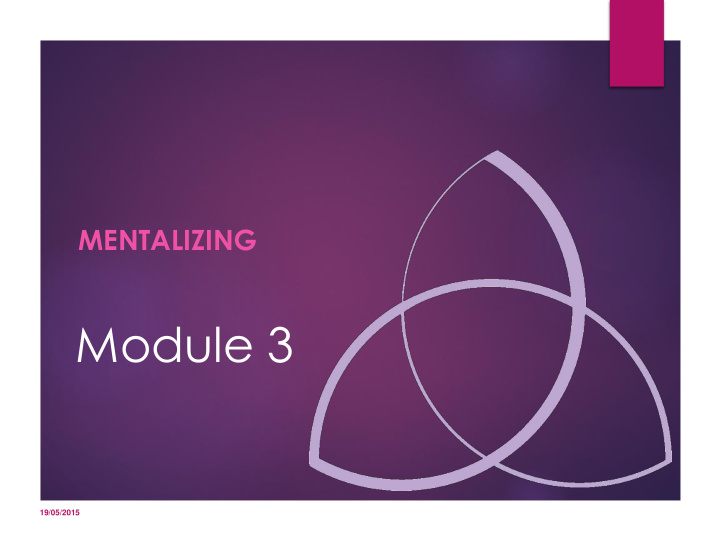



MENTALIZING Module 3 19/05/2015
2 Agenda 1. What is mentalizing? 2. Characteristics of mentalizing 3. If someone isn’t mentalizing 4. A mentalizing attitude 5. Resolving conflict
3 Introduction • Mentalizing: Taking both • People with BPD are self and others’ states of more likely to lose the mind into account ability to mentalize and make others lose theirs • Mindfulness (Module 2) is self-orientated, with the • We need to be aware of focus on our own mind thinking, emotions and actions in ourselves and • Mentalizing is being others mindful of another mind
4 What is mentalizing? Having the ability to imagine Definition : things and to develop ideas in To construct or picture in our minds makes us human the mind, to imagine, or to give a mental quality to an Two major aspects: action or behaviour Mentalizing of ourselves • Mentalizing of others •
5 http://youtu.be/9CEr2GfGilw?t=30s
6 How many cats in the picture?
7 What is mentalizing? What was he Why did I thinking when act like that? he did that? It is vital to maintain 1. mentalizing Non-mentalizing 2. leads to more non-mentalizing Step back, self- 3. observe and reflect ‘Self - reflection loop’ 4.
8 Self-reflection loop inside the experience enabling us to influence the outcome Different action Observe if wanted Participate Participate Observe
9 When there is no mentalizing • No true communication if Two very different views of we can’t understand each the same situation: other http://www.youtube.com/watch?v=XSQ YydXVaQ0 • No sense of security • Inability to ‘read people’ makes us uncomfortable, suspicious and mistrustful • Mentalizing is vital for mental health, social function and intimate relationships
10 Characteristics of mentalizing A trusting attitude Curiosity • • Humility The stance of safe • • uncertainty Playfulness and humour • Reflective contemplation • Willingness to take turns • Perspective-taking • Belief in changeability • Forgiveness • Assuming responsibility • and accepting Impact awareness • accountability
11 If someone isn’t mentalizing May become unreasonably Recognise your feelings • • upset or angry, leading to more Recognise your thoughts • non-mentalizing Think about what their feelings • Can become preoccupied with • might be rules, ‘shoulds’ and ‘should Think about what their thoughts nots’, deny involvement, blame • might be others and focus on absolutes Think about what might happen • Once considered, resume the If this happens, pause ! conversation
12 A mentalizing attitude PACTS for a Mentalizing attitude: • P atience • A ccepting different perspectives • C areful avoidance • T houghtfulness with humility • S ensitivity Notice face, eyes and voice – external mentalizing – but don’t make assumptions
13 Non-mentalizing traps Common non-mentalizing traps: • Making too many assumptions • Needing to be right and to win an argument • Telling people what they feel and why they are like they are
14 Resolving conflict Revisit the situation later, then: Establish your own level of tolerance, set boundaries, then: Establish facts and try to • Choose a time when you are both understand perspectives • calm Agree the problem • Express your expectations • Brainstorm how to resolve the • Avoid threats • problem Listen carefully • Negotiate a joint solution • State you’re seeking a joint solution • Never make threats you can’t carry • out Non-mentalizing may become a If you make a threat, apologise and • withdraw it repetitive and reinforcing cycle Ultimatum decisions taken in ‘cool’ • of the moment
Recommend
More recommend